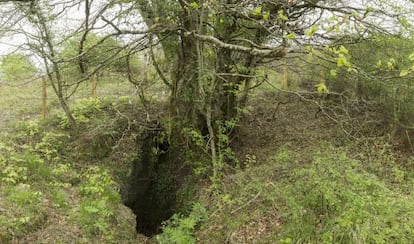Searching for the truth behind a Civil War atrocity
A pregnant woman and her six children were allegedly murdered at the outset of the conflict A new book reopens the case, in which the victims were supposedly thrown into a cave


On the night of August 30, 1936, in the first weeks of the Spanish Civil War, residents of the village of Gaztelu heard gunshots from the woods outside this small village nestling in the foothills of the Pyrenees, close to the French border.
A few days before, 38-year-old Juana Josefa Goñi Sagardía, pregnant with her eighth child, and with six others in tow, and been expelled from the village in the Bidasoa valley of Navarre by her neighbors, and was sheltering with her brood in a tumbledown shack in the forest.
To this day, local people refuse to discuss what might have happened that summer night
On the morning of August 31, the shack was reduced to a charred ruin and Sagardía and her children were gone, never to be heard from again. To this day, local people refuse to discuss what might have happened that summer night, but relatives of the family insist that the family was murdered and then thrown down a nearby cave, possibly while still alive.
Zozoya Goñi, now in her 80s, says her aunt, who had been the sole beneficiary of her parent’s inheritance, was penniless, and had been reduced to begging from neighbors. She was also accused by some in the village of sending her children out at night to steal chickens and vegetables from their gardens.
The first weeks of the Spanish Civil War (1936-1939) were chaotic, and in Navarre, as in many other areas, law and order broke down. The region sided with the nationalist forces of General Francisco Franco and there were dozens of arbitrary arrests, while many men were conscripted or recruited for forced labor, as was the case with Juana Josefa’s husband, Pedro Antonio Sagardía Agesta, and her eldest son, who were away when the family was forcibly removed from the community.
The first weeks of the Spanish Civil War were chaotic, and in Navarre law and order broke down
In many places, people took advantage of the situation to settle old scores, appropriating disputed land and property at gunpoint, sometimes turning their neighbors in to the authorities. Local militias were formed, curfews imposed, and people in small communities such as Gaztelu locked their doors and shuttered their windows at night.
A new book, ¿Qué fue de la familia Sagardía? (or, What happened to the Sagardía family?) by local historian José Marí Esparza, recounts the events that occurred 79 years ago, while supporting the Sagardía family’s calls for an excavation of the cave under the auspices of Spain’s Historical Memory Law, which aims to uncover wrongdoing by both sides in the civil conflict.
After she had taken refuge in the woods outside Gaztelu, Juana Josefa Sagardía sent a message to her husband. But he was arrested as soon as he approached the area and held by the Civil Guard for eight days, says Esparza. When he was released he was ordered to leave the area. He sent money through an acquaintance, but it was returned. He died shortly after the Civil War ended.
That night four shotgun blasts were heard. Perhaps the smallest ones were crying and were killed. But the others were thrown alive into the pit”
“Everybody knows what happened. That night four shotgun blasts were heard. Perhaps the smallest ones were crying and were killed. But the others were thrown alive into the pit. The next day people went up there to see if they could hear anything,” says Nati Zozoya Goñi, the 83-year-old niece of Juana Josefa Sagardía, who lived in the village as a child. “They threw stones and wood down there. Who would think that anybody could do such a thing. A few days before they were murdered, the children had eaten with us. One of them, Martina, wanted to stay, but we couldn’t keep her, my father was in prison. Afterwards, my mother was tormented by guilt and kept saying that she could have saved them.’”
Esparza agrees that many in the village knew what happened, and would have known who was responsible. An investigation was carried out by Juana Josefa’s brother-in-law, a member of the armed forces who sided with General Francisco Franco. The case was kept open for 10 years, but no trace of the family was found, and nobody came forward with any information. A man was even sent down on a rope into the cave, but said he found nothing.
Last December, a team of spelunkers went down the 50 meters into the bottom of the cave under the guidance of Francisco Etxeberría, a pathologist who has overseen dozens of excavations of mass graves from the Civil War era. A body was found, but it belonged to a young man who had gone missing while hiking in 2008. Few local people are prepared to say anything they might know about what happened that August night in 1936.
All I want before I die is for them to get those bones out there, and for them to be given a dignified end”
One person who is prepared to talk is an elderly woman who gives her name simply as Mariluz, and who lives in the nearby community of Santa Leocadia. “I was very young, but my mother knew Juana Josefa. There were seven or eight men who did it, they killed her. How brave. On his deathbed, one of them said he could see the children. And do you know what? Afterwards, chickens were still being stolen.”
The only other person able to shed light on what happened to Juana Josefa is 88-year-old Gloria Pedroarena, who married José Martín, her eldest son, who died in 2007. “He never talked about it. But he knew where they were, because sometimes people from the village came to see him and would say things. But it was painful. He carried something inside him, but would never say anything.”
Nati and Gloria met for the first time at the book launch on May 5 in Pamplona. Both accept that the truth about what happened all those years ago will never be fully explained, but that the most important thing is to establish if Juana Josefa and her six children, along with the unborn child she was carrying, were murdered and thrown into the pit, and if so, for their remains to be removed and given a proper burial. “All I want before I die is for them to get those bones out there, and for them to be given a dignified end,” says Nati.
Tu suscripción se está usando en otro dispositivo
¿Quieres añadir otro usuario a tu suscripción?
Si continúas leyendo en este dispositivo, no se podrá leer en el otro.
FlechaTu suscripción se está usando en otro dispositivo y solo puedes acceder a EL PAÍS desde un dispositivo a la vez.
Si quieres compartir tu cuenta, cambia tu suscripción a la modalidad Premium, así podrás añadir otro usuario. Cada uno accederá con su propia cuenta de email, lo que os permitirá personalizar vuestra experiencia en EL PAÍS.
¿Tienes una suscripción de empresa? Accede aquí para contratar más cuentas.
En el caso de no saber quién está usando tu cuenta, te recomendamos cambiar tu contraseña aquí.
Si decides continuar compartiendo tu cuenta, este mensaje se mostrará en tu dispositivo y en el de la otra persona que está usando tu cuenta de forma indefinida, afectando a tu experiencia de lectura. Puedes consultar aquí los términos y condiciones de la suscripción digital.
Últimas noticias
The complicated life of Francesca Albanese: A rising figure in Italy but barred from every bank by Trump’s sanctions
How Japan is trying to avert ‘digital defeat’
Half of Scotland is in the hands of 420 property owners
Reinhard Genzel, Nobel laureate in physics: ‘One-minute videos will never give you the truth’
Most viewed
- Pablo Escobar’s hippos: A serious environmental problem, 40 years on
- Why we lost the habit of sleeping in two segments and how that changed our sense of time
- Charles Dubouloz, mountaineering star, retires at 36 with a farewell tour inspired by Walter Bonatti
- Reinhard Genzel, Nobel laureate in physics: ‘One-minute videos will never give you the truth’
- The Florida Keys tourist paradise is besieged by immigration agents: ‘We’ve never seen anything like this’








































